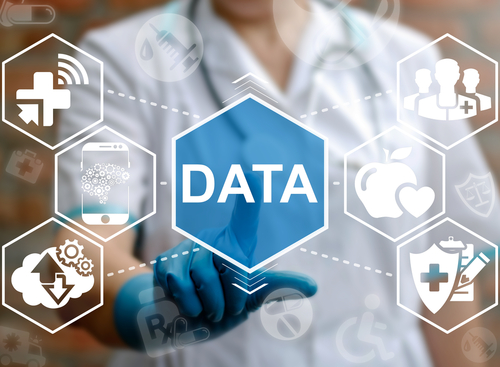Despite many people having never heard of APIs, the powerful technology is utilized every day in popular applications such as Yelp, Twitter, Facebook, and LinkedIn. But, its uses extend far beyond social media. From revolutionizing art discovery to healthcare breakthroughs, APIs have a growing role in nearly every industry.
Healthcare APIs, along with Artificial Intelligence, is on the brink of revolutionizing healthcare. However, in order for breakthroughs such as predictive analysis to take place, the connection must be made to Big Data.
To start, this article will define an API diagram before moving into a discussion about Artificial Intelligence in healthcare. Data scientists will finish with an understanding of the relationship between healthcare APIs, Artificial Intelligence and Big Data.
What is an API diagram?
The acronym API stands for Application Programming Interface. Essentially, an API is a software intermediary that allows two applications to talk to each other. Thomas Davis of Medium’s Towards Data Science blog says it helps to think of an API as a translator. Even if two people don’t speak the same language, they can still communicate using a go-between.
Just like human translators, APIs are incredibly useful. Their versatility makes them vital technology; however, APIs can be difficult to create. That’s where an API diagram comes in.
In order to successfully create an API, programmers must be very organized during development. To organize ideas and input, programmers should consider making a visual representation, such as a flowchart, for reference. Creating API diagrams will help streamline a complex process. Prior to writing any code, programmers can use Unified Modeling Language to draw a blueprint of their API development.
By taking the time to create an API diagram, programmers will have a clear outline of what they want the API to be, what its function is and what data it will need to capture. Furthermore, an API diagram is an easy way to gather and organize input from other team members contributing to development. With a proper API diagram, great brainstorm ideas are far less likely to get lost in the shuffle.
In an API diagram, the lead programmer and team members should record processes for the calls being used for each API, integration requirements and how errors should be handled. The visual nature of an API diagram will make the information more accessible and easier to understand. It will also encourage collaboration, including with less technical-minded team members.
Artificial Intelligence in Healthcare
Like API diagrams, APIs themselves help to simplify the life of a programmer. They also play a vital role in Artificial Intelligence programming.
Oleksii Kharkovyna explains on Medium’s Toward Data Science blog that Artificial Intelligence programming involves integrating commercial APIs into existing platforms. Together, Artificial Intelligence and APIs make a variety of otherwise time-consuming and laborious tasks possible such as face detection, face recognition, text analysis, natural language processing, and data analysis.
When it comes to efficient data analysis, Artificial Intelligence has become the most sought-after technology to help innovate and transform industries, according to the Dataquest article “Power of Artificial Intelligence and Big Data Analytics: Intelligence that Mirrors Human Behaviour.”
Healthcare is no exception. As in other industries, healthcare organizations are weighing implementing Artificial Intelligence along with analytics to assist with daily tasks. In fact, the healthcare industry stands to benefit from data analytics technology more than most.
For example, with the help of technology, Dataquest reported that a patient could be diagnosed with high blood pressure based solely on a retina scanning. Such a scenario isn’t so far off. Other uses of AI in healthcare include patient data processing, biomarker discovery, automated report generation and computational drug discovery. By leveraging and correlating multiple data sets and applying AI techniques, healthcare could count predictive analysis as one of its biggest breakthroughs in modern history.
What’s the Big Data Connection?
In order for such a breakthrough to take place, predictive analysis will need to be combined with Big Data, according to Dataquest. To do so, Cloud computing must be leveraged so that critical insights are available faster and with greater accuracy.
The Big Data connection is evident. Before predictive analysis, such as the high blood pressure diagnosis based on a retina scanning, can take place, Artificial Intelligence must catalog the available Big Data as well as its associated quality metrics. In healthcare, the available Big Data will mostly come from electronic health records.
Traditionally, doctors’ offices, clinics, and hospitals kept physical health records for their patients. Today, in part to make them easier to share, many of the larger health organizations are trending toward electronic health records. As medical data moves into Big Data space, the healthcare industry takes a step closer to implementing predictive analysis.
Since a significant portion of Machine Learning, the dominant form of AI, occurs in the Cloud, Dataquest reported that it’s essential healthcare organizations push the data on to Cloud storage. To take advantage of unconstrained computing power, a cost-effective Cloud service to integrate data will most likely be necessary. On another front, HIPPA and privacy concerns are slowing the process. To protect sensitive medical data, cybersecurity innovation is a priority.
Together, Machine Learning and Big Data analytics can revolutionize healthcare. With healthcare Application Programing Interfaces and Artificial Intelligence, the healthcare industry can better detect, learn and optimize operations while improving the quality, safety, and cost-effectiveness of its services.
About the Author

Avery Phillips is a freelance human based out of the beautiful
Treasure Valley. She loves all things in nature, especially humans.
Leave a comment down below or tweet her @a_taylorian with any questions or comments.
Sign up for the free insideBIGDATA newsletter.





Great job, i love this topic & especially the way you have explained it is really awsome. Thnaks for sharing this info..